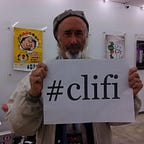In 2005, British nature writer Robert Macfarlane wrote an essay titled “The Burning Question” in the Guardian in which he asked: in this time of climate change, where is all the climate change literature?
The same year, American writer Bill McKibben posed the same question in an essay in Grist magazine.
I hope one of them, or both of them, will revisit their 2005 pieces and update their ideas to 2015, since 10 years later there is an answer that they might find useful: the emergence of a new literary genre that’s been dubbed “cli-fi”(for “climate change fiction novels and stories”).
I know a little about cli-fi because I coined the term just for this purpose, and I think it is resonating with young writers and readers around the world.
One teenage girl in Norway sent me a class paper she wrote (in Norwegian) about climate change novels in her country and about her own understanding of how cli-fi could serve as a useful wake-up call about climate issues. She’s not the only one. In school classrooms around the world, including Britain and Finland, Sydney and New York, young students are learning about and discussing cli-fi themes in novels and movies.
You might say that cli-fi has arrived.
While more and more authors are penning cli-fi novels — with movie scriptwriters creating cli-fi screenplays to try to sell to Hollywood as well — classrooms worldwide are now focusing attention of this rising genre of literature and cinema.
“Literary fiction has dreamed up many versions of the end of the world, but how is contemporary fiction dealing with the threat of climate change?” asks professor Jenny Bavidge at the University of Cambridge, who taught a class on cli-fi last summer at the Institute of Continuing Education there.
Cli-fi is a catchy abbreviation for the genre of “climate fiction,” much in the same way that “sci-fi” is a nickname for “science fiction.” With news articles about the rise of cli-fi appearing in the Guardian and the New York Times, teachers now see an opportune time to introduce “cli-fi” classes into the curriculum.
Bavidge told her students in the introduction to her class last summer: “This course will focus on works by contemporary authors, including Margaret Atwood and Ian McEwan, and will ask whether “cli-fi” imagines solutions as well as ends.”
“As people living through this particular historical moment, we may want to ask how far [cli-fi] novels contribute to efforts to better understand our relationship with the planet and its ecosystems,” she said.
One of my mentors in the world of literature is the American sci-fi novelist David Brin. I once asked him about how climate change themes have been influencing sci-fi novels and movies, and he told me by email: “Global warming and flooding were important in my 1989 novel ‘Earth,’ but they were earlier featured in the film ‘Soylent Green’ based on Harry Harrison’s novel ‘Make Room, Make Room!’”
Classes about cli-fi for teenagers and young adults have been set up around the world this year, from Norway to India. This is big. This is global. This is for young people who will inherit the future.
Several non-English speaking countries are also looking at ‘’cli-fi’’ and how it impacts their own literary cultures, including Brazil, Spain, Germany and France.
Over 1,000 young people worldwide have taken part in “cli-fi” classes in the past three years. And that’s just the tip of the iceberg.
It’s a beginning. And there’s more to come.
There is, of course, a long history of teaching “sci-fi” in high schools and colleges, with several universities even setting up literature departments that specialize in sci-fi research.
Now “cli-fi” is finding a room of its own as well.
Look at just two of the many course titles that I have seen so far archived online: “Cli Fi: Stories and Science from the Coming Climate Apocalypse,” and “Cli-fi: Science Fiction, Climate Change, and Apocalypse.”
Novels discussed in one college class last year included Paolo Bacigalupi’s “The Windup Girl,” Barbara Kingsolver’s “Flight Behaviour,” and Ian McEwan’s “Solar.” There was at least one “zombie apocalypse” in the curriculum, too!
So there you have it. “Cli-fi” has reached into the minds of young readers and writers. It answers the important question posed by Bill McKibben and Robert Macfarlane in 2005.
It’s a worldwide trend now because global warming impacts us all, and literature and cinema always respond to the things that matter.
Read more like this on Medium by clicking the tags below.
